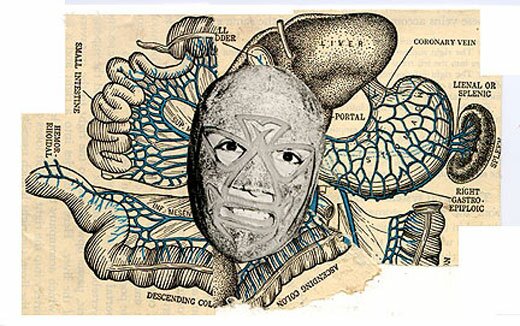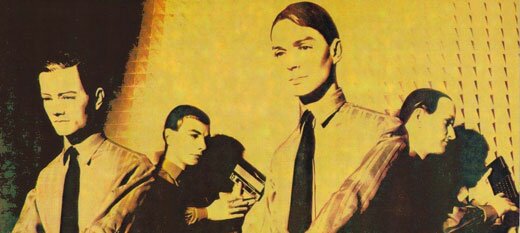music
Archived Posts from this Category
Archived Posts from this Category
Posted by ben on 25 May 2007 | Tagged as: music, rock!, video/film
Magma is a French prog-rock outfit that formed in 1969. Although they are known for epic orchestral arrangements inspired by Carl Orff, I love this stripped-down vocal, piano and bass version of Otis from 1981. Founding drummer / singer Christian Vander sings about the destruction of the earth in a language he constructed called Kobaïan. Buying can get pricey, but I just noticed their albums are dirt-cheap on iTunes.
Posted by ben on 15 May 2007 | Tagged as: music
I just found this video of Charalambides’ March performance at Salon Mijangos on YouTube. Lee Jackson (Dallas-based music writer for Foxy Digitalis and Broken Face) has a few kind words about the show in his SXSW recollections as well.
Posted by ben on 14 May 2007 | Tagged as: music, sound art, video/film
This film was produced for the Phillips Pavilion at the 1958 World’s Fair in Brussels by Le Corbusier, Edgar Varèse, and Iannis Xenakis. It was shown in an exhibition space (described more fully below) which included 425 speakers, so that the sounds could follow complex routes through the space. Watching it on YouTube is a far cry from the intended experience, but is rewarding nonetheless. For a more complete examination of this ground-breaking project, check out Marc Treib’s “.”
“Poème électronique” is the first electronic-spatial environment to combine architecture, film, light and music to a total experience made to function in time and space. Under the direction of Le Corbusier, Iannis Xenakis’ concept and geometry designed the World’s Fair exhibition space adhering to mathematical functions. Edgar Varèse composed the both concrete and vocal music which enhanced dynamic, light and image projections conceived by Le Corbusier. Varèse’s work had always sought the abstract and, in part, visually inspired concepts of form and spatial movements. Among other elements for “Poème électronique” he used machine noises, transported piano chords, filtered choir and solo voices, and synthetic tone colorings. With the help of the advanced technical means made available through the Phillips Pavilion, the sounds of this composition for tape recorder could wander throughout the space on highly complex routes.
“The Philips Pavilion presented a collage liturgy for twentieth-century humankind, dependent on electricity instead of daylight and on virtual perspectives in place of terrestrial views.” — Marc Treib,
Posted by michelle on 10 May 2007 | Tagged as: music, performance art
I sifted through a lot of riff raff to find this amazing example of Chinese Opera. The sui generis sounds of drums and gongs found in Chinese theatre have to be some of my favorite all time auditory delights. Watch out for the treble on this one though.
Posted by ben on 30 Apr 2007 | Tagged as: music, performance art, video/film
Around the same time that Destroy All Monsters started playing around with strange music and film footage, The Residents embarked on their underground film project, Vileness Fats. Although the film was never completed, some of the footage was used for music videos in the coming years. From the official Residents web site:
The world of Vileness Fats, consisting of a village, a cave, a desert and a nightclub, is tiny, claustrophobic and primarily populated by one armed midgets…. Two versions of the incomplete feature have been released: the 32 min long “Whatever Happened to Vileness Fats?” (1984) and the tighter 17 1/2 min “Vileness Fats (Concentrate)” (2001), and both come across as artifacts from some hellish but mildly amusing nightmare — the claustrophobic product of a model railroad builder’s beyond bad acid trip.
Here is some of the footage, with part of the classic “Third Reich ‘n Roll” (a commentary on the fascism of the music industry) as the soundtrack:
Also check out the Buñuelesque .
Posted by ben on 27 Apr 2007 | Tagged as: interviews, music

You all know Mark Mothersbaugh for his role in the founding of DEVO, for his work on various soundtracks (including the Pee-wee Herman Show, Rushmore, The Rugrats, and even Revenge of the Nerds II, among others). Although he is less known for his visual art, he has been steadily producing work in this area for decades; in fact, it was while studying art at Kent State that he formed DEVO, partly in response to the Kent State shootings. His work draws on ideas pioneered by the Fluxus movement, with its mixture of whimsy and starkness. Mothersbaugh’s “Postcard Diaries” will be opening at FL!GHT Gallery on May 12, alongside an installation by Sarah Higgins at Salon Mijangos, new work by Kelly Pierce at One9Zero6 Gallery, and music by Hyperbubble and others. He recently agreed to do an email interview with me: Continue Reading »
Posted by ben on 23 Apr 2007 | Tagged as: music, performance art, video/film
Destroy All Monsters, whose founding members include Mike Kelley and Jim Shaw, was a legendary Detroit anti-rock band with almost no recorded output other than a DVD called , and a now out-of-print 3-CD set released on Ecstatic Peace (a few other live recordings have trickled out and are available here). The group’s shows were an abrasive blend of noise, performance art, and visual chaos. Grow Live Monsters includes no-budget Destroy All Monsters film footage from 1971 to 1976. Around 1976 Kelley and Shaw left the group to pursue their visual art careers, and were replaced by Ron Asheton from the Stooges and MC5 bassist Michael Davis. Here’s a clip from the DVD:
Posted by ben on 16 Apr 2007 | Tagged as: music, sound art, video/film
I just discovered Piotr Kamler while searching YouTube for work by Bernard Parmegiani (Parmegiani scored some of Kamler’s films). Kamler’s films are a kind of lyrical, abstract take on science fiction, with stunning animation sequences executed in a wide variety of media.
Here’s Une Mission Ephemere (1993; scored by Parmegiani):
Also check out (scored by Francois Bayle). Here’s a good discussion of the work of Kamler and his contemporaries. And if you like the soundtrack: two Parmegiani albums are available for download on Mutant Sounds right now.
Posted by ben on 16 Mar 2007 | Tagged as: music, upcoming events
Here’s a little taste of Charalambides live. I’ve been wanting to bring this neo-psych duo through San Antonio for awhile, and it’s finally happening this Sunday at Salon Mijangos. Click the event listing to the right for more details on the show.
Posted by ben on 01 Mar 2007 | Tagged as: essays, music

Following up on the Kraftwerk video I posted last week, I thought y’all might like a little background on what these guys were trying to accomplish. I find it interesting that critical writing about music most often emphasizes the formal and emotional aspects of the work, and generally disregards the philosophical implications. Visual art criticism, on the other hand, often focuses on the conceptual aspects of the work to the point that the discussion revolves around ideas that are tangential to the actual pieces. In any case, here’s an excerpt from a Lester Bangs interview with Kraftwerk from 1975 which gets to the heart of the Kraftwerk philosophy (read the whole thing on the Creem site):
They referred to their studio as their “laboratory,” and I wondered aloud if they didn’t encounter certain dangers in their experiments. What’s to stop the machines, I asked, from eventually taking over, or at least putting them out of work? “It’s like a car,” explained Florian. “You have the control, but it’s your decision how much you want to control it. If you let the wheel go, the car will drive somewhere, maybe off the road. We have done electronic accidents. And it is also possible to damage your mind. But this is the risk one takes. We have power. It just depends on what you do with it.”
I wondered if they could see some ramifications for what they could do with it. “Yes,” said Ralf, “it’s our music, we are manipulating the audience. That’s what it’s all about. When you play electronic music, you have the control of the imagination of the people in the room, and it can get to an extent where it’s almost physical.”
I mentioned the theories of William Burroughs, who says that you can start a riot with two tape recorders, and asked them if they could create a sound which would cause a riot, wreck the hall, would they like to do it? “I agree with Burroughs,” said Ralf. “We would not like to do that, but we are aware of it.”
“It would be very dangerous,” cautioned Florian. “It could be like a boomerang.”
“It would be great publicity,” I nudged.
“It could be the end,” said Florian, calm, unblinking. “A person doing experimental music must be responsible for the results of the experiments. They could be very dangerous emotionally.”
I told them that I considered their music rather anti-emotional, and Florian quietly and patiently explained that “‘emotion’ is a strange word. There is a cold emotion and other emotion, both equally valid. It’s not body emotion, it’s mental emotion. We like to ignore the audience while we play, and take all our concentration into the music. We are very much interested in origin of music, the source of music. The pure sound is something we would very much like to achieve.”
Posted by ben on 26 Feb 2007 | Tagged as: music
 If you’re looking for cheap but hip collectibles to decorate your walls and your sound space, these are the sites for you. Steven Leiber Basement has everything from Dada mail art to General Idea multiples to posters and catalogs for Sol LeWitt and Joseph Beuys shows. They have a huge catalog, and a lot of it is relatively cheap. Mutant Sounds has rips of some incredibly rare records and tapes that are pretty much impossible to find in their original formats. Psychedelic, prog, krautrock, free improv, it’s all here. You probably won’t know what most of the stuff is (unless you’re a total music geek), but that makes it all the more fun to explore.
If you’re looking for cheap but hip collectibles to decorate your walls and your sound space, these are the sites for you. Steven Leiber Basement has everything from Dada mail art to General Idea multiples to posters and catalogs for Sol LeWitt and Joseph Beuys shows. They have a huge catalog, and a lot of it is relatively cheap. Mutant Sounds has rips of some incredibly rare records and tapes that are pretty much impossible to find in their original formats. Psychedelic, prog, krautrock, free improv, it’s all here. You probably won’t know what most of the stuff is (unless you’re a total music geek), but that makes it all the more fun to explore.
Posted by ben on 23 Feb 2007 | Tagged as: music, video/film
I’m honestly not sure if this Kraftwerk video presents a chilling vision of the future, or a glorious dream that one day all men will wear blinking ties. Maybe that’s what makes it so brilliant, a perfect Friday afternoon treat.